Cave Hill & the Seven Sisters Creation Story
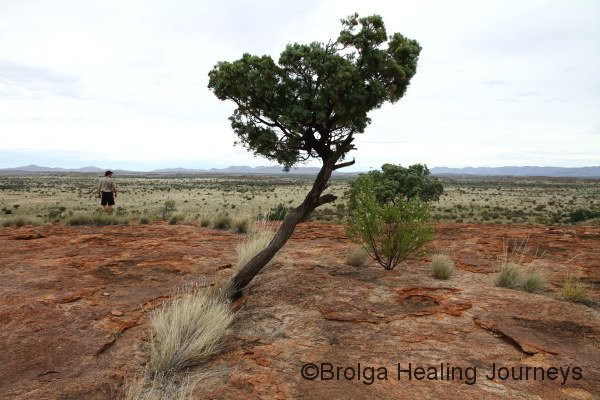
The day after our trip to Mt Conner we were booked with the same company (SEIT in partnership with the indigenous owned Desert Tracks), for a trip to Cave Hill.
Cave Hill is in the Musgrave Ranges, around 100km south of Uluru, but the country remains within Pitjantjatjara lands. When we learned that Cave Hill had the most significant art site within central Australia, we were sold on the tour, especially given that the tour provided the only way for us to visit.
We were part of another small group – just the two of us, our driver/guide Brett whom we had met on the Mt Conner tour, and Jacques and Elaine, a couple who had migrated from South Africa seven years ago. They have a love of wildlife and wildflowers, and also expressed the desire to learn as much as they could about Aboriginal culture. In other words, we had plenty in common.
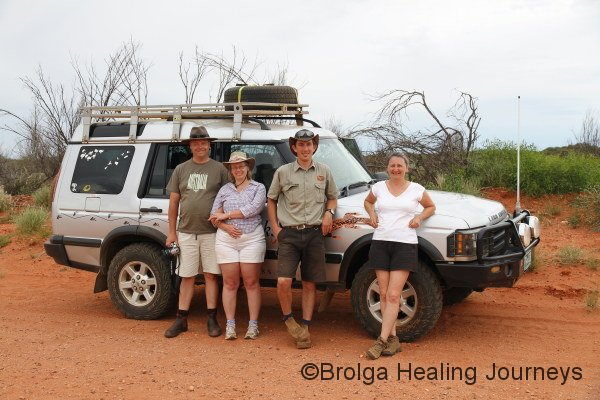
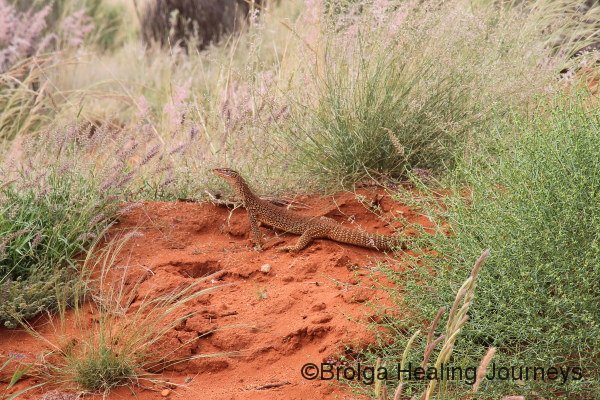
Off we headed, retracing part of our route of the previous day towards Mt Conner, but turned south along Mulga Park Road, bound for South Australia. The road wasn’t too bad – some corrugations and sandy stretches – but the abundance of wildlife, including plenty of Sand Goannas and several large flocks of Budgerigars – made travel a joy. And once again the countryside was in magnificent condition, covered in grass, healthy Mulga trees and wildflowers.
We crossed into South Australia, where Brett stopped and asked to see our visas (cheeky bugger), before heading south west to Cave Hill. We arrived mid morning, to be greeted by a pack of friendly, if slightly wild looking, dogs from the nearby community.

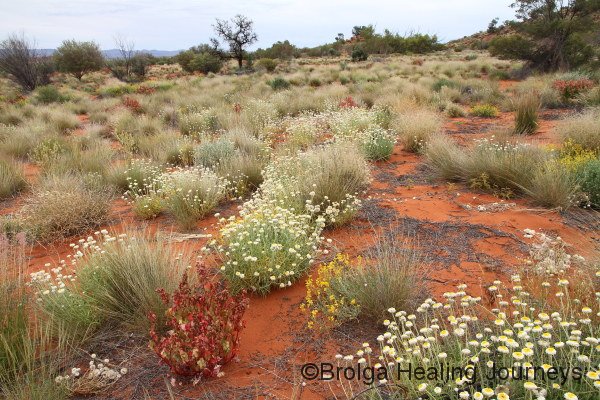
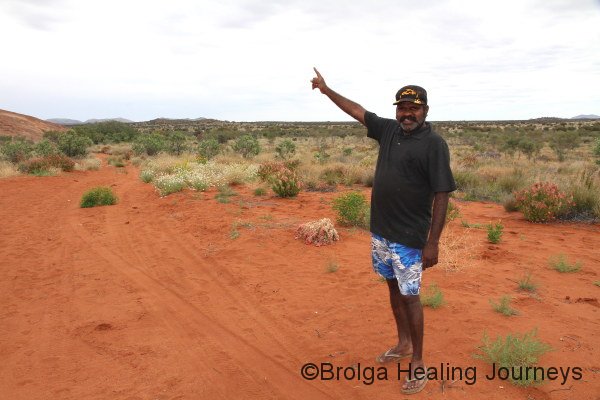
The local custodians of Cave Hill request that visitors take no photos of Cave Hill itself (other than from its top), the rock art, or the nearby burial grounds. For an avid photographer like me, this was disappointing to say the least, but I completely accepted and appreciated the request. If anything, this enriches our experience there, keeping the memory precious, and means also that Cave Hill will continue to have an almost overwhelming effect on everyone who has the privilege of visiting, because the few photos they might see before visiting Cave Hill, and its art site, will give little impression of their majesty.
Cave Hill is a very important site, and was a ceremonial site for people from many different regions, some far away. It is part of a number of songlines, and three we learned of were the Seven Sisters songline, the Perentie songline and the Honey Ant songline.
The Seven Sisters songline is possibly the longest across Australia, travelling from the gulf country of Queensland, down through the Northern Territory, through Cave Hill, and continuing through South Australia to the Great Australian Bight. In brief, a songline links different places through a particular creation story, covering the pathways travelled by ancestral beings during Tjukurpa (creation time) as they gave form to the landscape. The songs were passed down from generation to generation, and provided a continual link to and understanding of the land, but also had a practical use in describing travel and trade routes, the location of waterholes and the presence of food.
I won’t go into much detail about the Seven Sisters story, because it is not mine to tell. But I can say that the story relates to the Pleiades constellation, known as the Seven Sisters, and the constellation we know as Orion, or Wati Nehru to the Anangu (local people). In this story, Wati Nehru pursues Seven Sisters across the land, just as Orion pursues the Pleiades constellation across the heavens. In an interesting twist to the story, Wati Nehru had a ‘second creation’, which is a lovely way of saying that he had a second, detachable, penis. This penis had a mind and will of its own and pursued the sisters relentlessly across the then formless landscape, causing all manner of trouble, but also given the land its current features. Eventually, he chased them into the sky, where we can still witness their ongoing chase night after night. The story remains a wonderful parable for our modern world, where so many people (okay, men mainly!) continue to ‘think’ with their genitals and bring all manner of havoc upon themselves, their families and society. Nothing much has changed. So the story teaches us the lesson of controlling lust, and also of the power of sisterhood.
We were taken around Cave Hill, bringing this story to life. Every landform there was part of the story, representing the sisters, Wati Nehru or his second creation, or some action on their behalf. Cave Hill, in effect, represents just one chapter of the Seven Sisters Tjukurpa. To think that this story describes in detail land right across Australia simply fills you with awe.
Then we were led into the cave. My God, it was breathtaking. We were stunned by a huge ceiling of rock art, the most amazing I have ever seen. We were all dumbfounded. It was the same feeling one gets within the Sistine Chapel, and this was just as sacred,with a feeling of enormous spiritual impact. But Cave Hill is much older, more organic, and more mysterious. Story after story are told there through rock art, some works old, some new, some colourful and others faded through the thousands of years the cave has been occupied. Lee Brady, one of the Elders responsible for protecting Cave Hill, and also the director of Desert Tracks, told us some of the stories, and the meaning of certain symbols. Others he could not tell us, for we were not initiated and therefore not privy to their secrets. All I can say is go there, one day, if you get the opportunity, and witness and experience the art of Cave Hill for yourself.
We were next led out of the cave, following footprints left in Creation Time by the Seven Sisters, up onto the top of Cave Hill. We were astonished by the view – a 360 degree panorama taking in Uluru, Kata Tjuta, Mt Conner, the Musgrave Ranges and many more. We were also bewildered to see such a view, because we couldn’t recall even seeing Cave Hill on our drive in, and even from the shelter nearby, where we had parked and had morning tea and lunch> The shelter was easily visible from the hilltop, but from the shelter you could barely see the hill. This may be due to the rounded nature of the hill, which prevents one from easily seeing its top from below, and perhaps the panoramic view from the hill-top is the result of very flat country in its nearby surrounds. But to us, Cave Hill seemed a strange, hidden and powerful place, one you could easily pass by without noticing, unless you had been invited to share its mysteries by its custodians.
We sat for some time on the hill-top as Lee weaved his magic through stories, some hilarious, other poignant, but all giving a wonderful insight into the life of the Anangu, reminding us in his words that while we may wear different clothes (ie skin colours) we are all one humanity. He sang some of his people’s songs, taking us to another time, and we could have sat there forever listening to them and looking out over that timeless landscape.
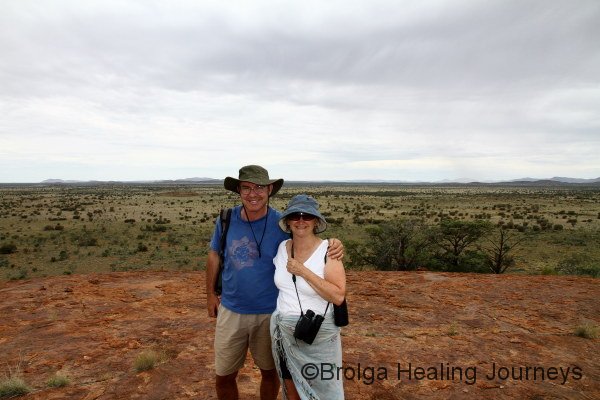
Lee also described to us the traditional blood group and marriage systems of his people, and for once we managed to understand them in all their complexity. It was interesting and enlightening to hear his understanding of current world events and troubles, seen through Tjukurpa. He was a wonderful teacher – low key, relaxed and humourous, but also able to impart a deceptive amount of information in a relatively short time.
Our visit to Cave Hill was a remarkable experience, enriching on many levels. We both feel grateful and privileged for the opportunity.
Peter
3 December 2010















